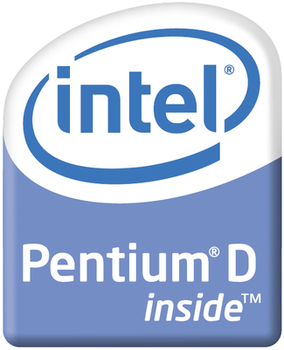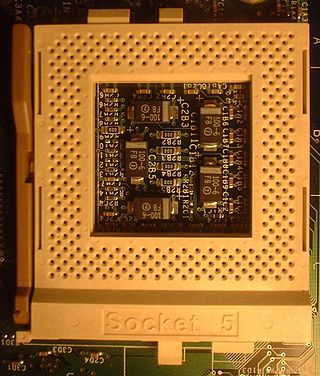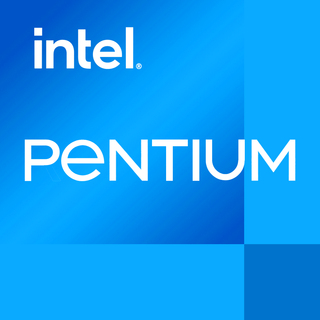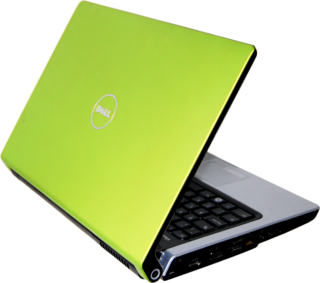
The Intel 486, officially named i486 and also known as 80486, is a microprocessor. It is a higher-performance follow-up to the Intel 386. The i486 was introduced in 1989. It represents the fourth generation of binary compatible CPUs following the 8086 of 1978, the Intel 80286 of 1982, and 1985's i386.

The Pentium is a fifth generation, 32-bit x86 microprocessor that was introduced by Intel on March 22, 1993, as the very first CPU in the Pentium brand. It was instruction set compatible with the 80486 but was a new and very different microarchitecture design from previous iterations. The P5 Pentium was the first superscalar x86 microarchitecture and the world's first superscalar microprocessor to be in mass production—meaning it generally executes at least 2 instructions per clock mainly because of a design-first dual integer pipeline design previously thought impossible to implement on a CISC microarchitecture. Additional features include a faster floating-point unit, wider data bus, separate code and data caches, and many other techniques and features to enhance performance and support security, encryption, and multiprocessing, for workstations and servers when compared to the next best previous industry standard processor implementation before it, the Intel 80486.

Celeron is a series of low-end IA-32 and x86-64 computer microprocessor models targeted at low-cost personal computers, manufactured by Intel. The first Celeron-branded CPU was introduced in April 15, 1998, and was based on the Pentium II.

Pentium 4 is a series of single-core CPUs for desktops, laptops and entry-level servers manufactured by Intel. The processors were shipped from November 20, 2000 until August 8, 2008.

The Pentium II brand refers to Intel's sixth-generation microarchitecture ("P6") and x86-compatible microprocessors introduced on May 7, 1997. Containing 7.5 million transistors, the Pentium II featured an improved version of the first P6-generation core of the Pentium Pro, which contained 5.5 million transistors. However, its L2 cache subsystem was a downgrade when compared to the Pentium Pros. It is a single-core microprocessor.

The Pentium III brand refers to Intel's 32-bit x86 desktop and mobile CPUs based on the sixth-generation P6 microarchitecture introduced on February 28, 1999. The brand's initial processors were very similar to the earlier Pentium II-branded processors. The most notable differences were the addition of the Streaming SIMD Extensions (SSE) instruction set, and the introduction of a controversial serial number embedded in the chip during manufacturing. The Pentium III is also a single-core processor.

The Pentium Pro is a sixth-generation x86 microprocessor developed and manufactured by Intel and introduced on November 1, 1995. It introduced the P6 microarchitecture and was originally intended to replace the original Pentium in a full range of applications. While the Pentium and Pentium MMX had 3.1 and 4.5 million transistors, respectively, the Pentium Pro contained 5.5 million transistors. Later, it was reduced to a more narrow role as a server and high-end desktop processor and was used in supercomputers like ASCI Red, the first computer to reach the trillion floating point operations per second (teraFLOPS) performance mark. The Pentium Pro was capable of both dual- and quad-processor configurations. It only came in one form factor, the relatively large rectangular Socket 8. The Pentium Pro was succeeded by the Pentium II Xeon in 1998.
The Pentium OverDrive was a microprocessor marketing brand name used by Intel, to cover a variety of consumer upgrade products sold in the mid-1990s. It was originally released for 486 motherboards, and later some Pentium sockets. Intel dropped the brand, as it failed to appeal to corporate buyers, and discouraged new system sales.
Tejas was a code name for Intel's microprocessor, which was to be a successor to the latest Pentium 4 with the Prescott core and was sometimes referred to as Pentium V. Jayhawk was a code name for its Xeon counterpart. The cancellation of the processors in May 2004 underscored Intel's historical transition of its focus on single-core processors to multi-core processors.

Intel's i486 OverDrive processors are a category of various Intel 80486s that were produced with the designated purpose of being used to upgrade personal computers. The OverDrives typically possessed qualities different from 'standard' i486s with the same speed steppings. Those included built-in voltage regulators, different pin-outs, write-back cache instead of write-through cache, built-in heatsinks, and fanless operation — features that made them more able to work where an ordinary edition of a particular model would not.

The nForce4 is a motherboard chipset released by Nvidia in October 2004. The chipset supports AMD 64-bit processors and Intel Pentium 4 LGA 775 processors.
The Pentium F00F bug is a design flaw in the majority of Intel Pentium, Pentium MMX, and Pentium OverDrive processors. Discovered in 1997, it can result in the processor ceasing to function until the computer is physically rebooted. The bug has been circumvented through operating system updates.

Pentium D is a range of desktop 64-bit x86-64 processors based on the NetBurst microarchitecture, which is the dual-core variant of the Pentium 4 manufactured by Intel. Each CPU comprised two dies, each containing a single core, residing next to each other on a multi-chip module package. The brand's first processor, codenamed Smithfield and manufactured on the 90 nm process, was released on May 25, 2005, followed by the 65 nm Presler nine months later.

Vinod Dham is an Indian-American engineer, entrepreneur and venture capitalist. He is known as 'Father of the Pentium Chip' for his contribution to the development of Intel's Pentium micro-processor He is a mentor, advisor and sits on the boards of companies, including startups funded through his India-based fund Indo-US Venture Partners, where he is the founding managing director.

Socket 5 was created for the second generation of Intel P5 Pentium processors operating at speeds from 75 to 133 MHz as well as certain Pentium OverDrive and Pentium MMX processors with core voltage 3.3 V. It superseded the earlier Socket 4. It was released in March 1994. Consisting of 320 pins, this was the first socket to use a staggered pin grid array, or SPGA, which allowed the chip's pins to be spaced closer together than earlier sockets. Socket 5 was replaced by Socket 7 in 1995.

Socket 2 was one of the series of CPU sockets into which various x86 microprocessors were inserted. It was an updated Socket 1 with added support for Pentium OverDrive processors.

Pentium is a series of x86 architecture-compatible microprocessors produced by Intel. The original Pentium was first released on March 22, 1993.

The Pentium Dual-Core brand was used for mainstream x86-architecture microprocessors from Intel from 2006 to 2009 when it was renamed to Pentium. The processors are based on either the 32-bit Yonah or 64-bit Merom-2M, Allendale, and Wolfdale-3M core, targeted at mobile or desktop computers.

Dell's Studio brand was a range of laptops and desktops targeted at the mainstream consumer market. The computers sit above Dell's Inspiron and below the XPS consumer lines in terms of price and specifications. They differ from Dell's lower-end Inspiron models by offering slot-loading optical drives, media keys, more cover design options, faster processor options, HDMI and eSATA ports, LED-backlit screens and backlit keyboards.















